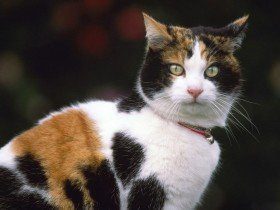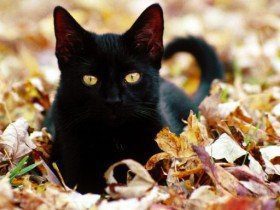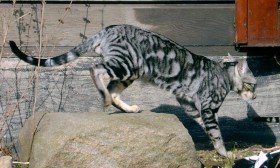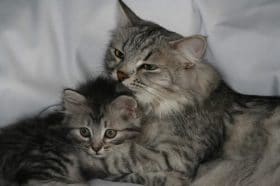The pattern of a cat indicates how the color on the surface of his body is distributed.
Patterns of coloration:
Tabby
Tabby pattern
The tabby pattern is the original pattern of the Pallas cat, of the Felis sylvestris, of theFelis lybica and of all the species of cats that preceded to the Felis domesticus, that is to say, our cats. And it is logical that asi was, because this pattern gives a perfect camouflage to hide from their enemies and overlooked their prey in natural environments in which they were developed.
ALL our cats have the tabby pattern, just not perceived. This pattern is produced by the action of two independent genes; the agouti and the tabby.
AGOUTI ANCESTORS
The ancestor of the domestic cat, el gato salvaje africano ¡Felis silvestris lybicaj. is a striped tabby, It uses this camouflage for survival. The hair between the stripes or spots tabby contains coloured areas, almost always pale base and dark tip. Other animals also have these areas of color in his cloak, among them the mouse, the squirrel and the agouti, the rodent that gives name to this pattern.
With stripes, in its four patterns:

- Blotched or marble: (wide stripes, with a characteristic “Bullseye” on the flanks and a butterfly on her shoulders)
- Mackerel or striped: (thin stripes, perpendicular to the backbone, as the skeleton of a fish)
- Spotted or mottled: (with rounded spots distributed regularly)
- Ticked or moles: (marbled, as a Hare) in the aforementioned base colors. Black tabby blotched, black tabby spotted, etc.
You have to remember that the tabby is not a breed – it is a color pattern, present in many breeds. It is to mean, the pattern is defined in the races of short hairs.
http://acagcuba.com
http://fractalcoon.com/
wilkipedia
Bicolor
Bicolor pattern

Is called bicolor, to copy, In addition to its genetic color, either integer or tabby, holder white. There is another pattern, I will see then it, It also has two colors, but does not have white, so it receives another name: to call bicolor, must necessarily be white. Individuals are called by What is + white. E.g.. black and white; Blue and white; Carmelite white and classic tabby, etc.
According to the number on each of the colors, they have received different names:
- Bicolor: (the white cover between a 30 and 50% of the body)
- Tuxedo: When you have approximately the 50% black and white and bilaterally: the lower half, that is to say, chest, white legs, abdomen and head, black back and tail. In the good copies, White must be cut in the shape of inverted triangle since in space between the eyebrows and continue with the white of the chest.
- Particolor: Are called with this same distribution copies, but with other color than black.
- Arlequin: (the white cover between a 50 and 75% of the body)
- Van: (white body, except for two spots of color which can cover the eyes and the base of the ears and tail). Black bicolor, black arlequin, black van, blue bicolor, etc.
- Footwear: When you have the white leg tips.
- Tie: When have a white patch on the chest.
- Buttons: Those who have white spots on the thorax and abdomen.
- Carey: A uniform mixture of Orange and black (or diluted versions of cream and blue) create this single layer pattern. A mix of black and orange, (as the red and white) It occurs almost exclusively in females.
- Bicolores smoke
Same characteristics of the bicolors plus the addition of smoke coloring.
- Tabby bicolour
Same characteristics of the bicolors plus the addition of the tabby pattern.
- Bicolour silver tabby
Same characteristics of the bicolors plus the addition of the tabby pattern and the silver coloration.
Tortie

Only females are tortie in general, the males which possess this pattern are sterile but this cause is very rare among them 1/1000.
The carapace of the turtle also called torties, It is a term used in the literature on cats and comes from the translation into English of turtle carapace is tortoise shell; the diluted version of torties are called blue-cream.
- Tortie
With beige spots or cream color base. Black tortie, blue tortie, chocolate tortie, lilac tortie, cinnamon tortie, fawn tortie.
Tricolor
Tricolor pattern

The tricolor pattern comes blank, black and Red (orange), or, in diluted versions of the cream and blue.
Basically, the relationship between white and color determines the number and distribution of spots of the other two colors.
Where there are little white, the other two colors are mixed between if, a pattern that may also be referred as a “shell of tortoise, and white.”
A true tricolor cat is one whose mantle features at the same time these three colors, What are the basic colors of cats, in their strong or diluted versions:
- orange (also known as red) or some of its variations: cinnamon, cream…
- black or some of its variations: blue/grey, lilac, brown…
- white
Himalaya (Colorpoints)
Colorpoints

Pointed cats have the body clear and the ears, the legs, the nose and tail darker. A sensitive enzyme in the heat of pigment cells controls this pattern. The normal body temperature inhibits the production of pigment, but where that is lower than, the enzyme is activated and color the hair. Because the fur is sensitive to temperature, pups are born white, cats are darker in cold countries, and in general all cats darken with age.
The pattern of the tips
A colourpointes a cat that face, ears, legs and tail are of a different colour to that of the rest of the body, in this seal point Siamese. This trait is also common in long-haired breeds., and the eyes of the colourpoint are always bright sapphire blue, regardless of the colour of the mantle.
Solid
Solid

Solid colors are scarce in nature since they do not provide a good camouflage.
Cats who have a solid color coat, they possess mainly non-agouti hair on their mantle. Even these cats carry the striped gene (tabby), what you can to, in the light, appreciate Dim atigradas marks or ghost marks.
Examples of solid color patterns:
Black, blue
chocolate, Lilac
red, cream
cinnamon, fawn.
The Silver or the Smokes.
The Silver or the Smokes.
- Silver Tabby

It is a dominant gene. The bottom of the hair is silver but is visually white. The drawings are based on the Brown cat color, blue, Kaminsky, cream, Turtle, Blue cream, silver white background.
Contrast must be sharp. The skin of the nose, pads and lips is the base color.
Color based on any of the 4 pattern tabby with the basis of pure white hair. Examples:
Black silver tabby blotched, black silver tabby spotted, etc.
- Smoke

It is the gene inibidor of the silver that gives this fur, but this time without tabby. The standard wants an entirely black cat (or another color) where only the opening of the hair when the cat moves shows a Fund's hair base (20% maximum of this luminous white). In addition the phantom spots are sometimes important as that may be confused with the silver tabby. They have the same defects of basic colors (redness of the black and blue,…) This leads, sometimes, unattractive colour.
The base of the hair is without pigment, the root is pure white and the tip is very intense in color, 1/3 White and 2/3 color. Examples:
Black smoke, blue smoke, chocolate smoke, lilac smoke, red smoke, Cream smoke, cinnamon smoke, fawn smoke, black tortie smoke, blue tortie smoke, chocolate tortie smoke, Lilac tortie smoke, cinnamon tortie smoke, Fawn tortie smoke.
